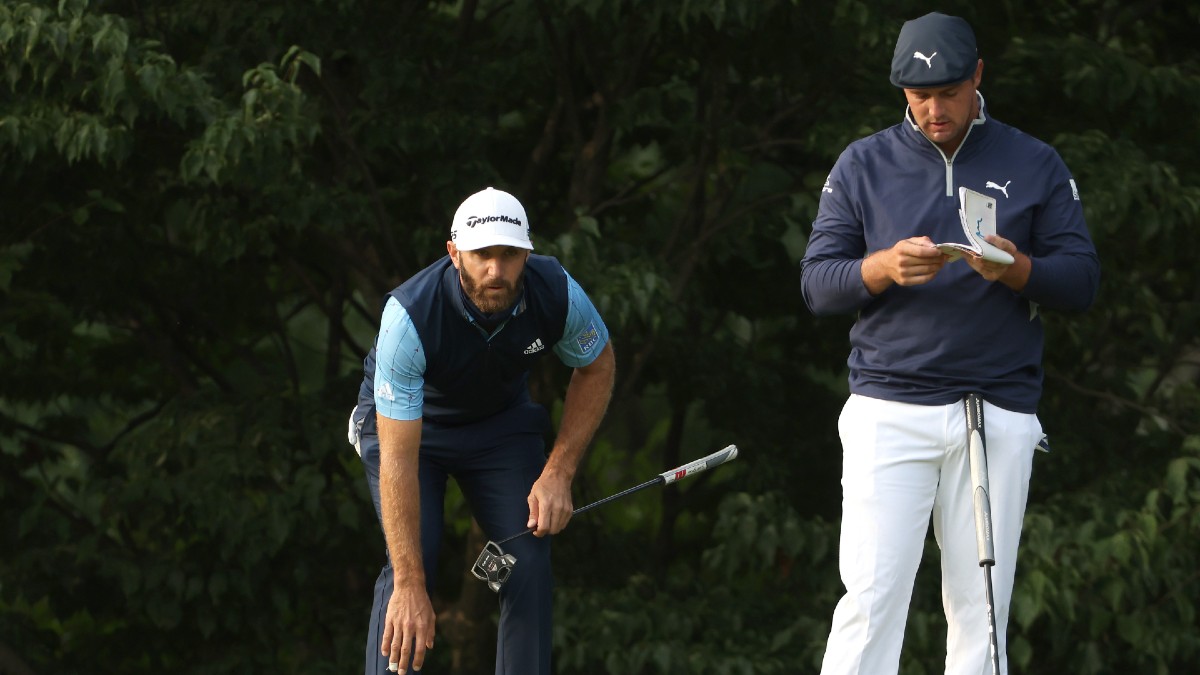Golf 3 ball betting rules

1. If a match/ball opponent does not start (e.g. player injured or disqualified before the start of a match) then all bets on that match/ball = void. · 2. · 3. · 4. For '3-Balls' or '2-Balls' markets, all bets on these markets will stand irrespective of whether the players play in the same group or pairing. One of the best ways to beat the golf betting market is to choose a strategy and stick to it. Whether that's betting 2-balls, 3-balls, golf 3 ball betting rules tops, find out. In a matchup with two golfers, a tie will just result in a push and your money back. Let's say you bet a 3-ball matchup at the PLAYERS in.
Golf 3 Ball Betting: Rules, Tips, & Strategies
A dead heat refers to ties in golf bets like Top 5s, Top 10s and Top 20s, or other markets like 3-ball matchups and first-round leaders. Like if four players tie for 10th, you won't receive the full payout for a Top 10 bet at most sportsbooks. When players tie, your bet amount is usually cut by how many players are tied for those spots.
So part of your bet is a loser, and the remainder stands at the original odds. BetMGM is the only U. MGM does not pay out in full for first-round leader bets. The tricky part on the surface is that the "ties" often go through T-5 or T — you may have five players tied for third at , and then the next player on the leaderboard finishes in eighth.
Here are two examples from the Charles Schwab Challenge, covering several of those circumstances. That's because there were only three spots for four tied players in the Top 5. It was essentially one extra player occupying the position you needed to cash your bet. Tenth-place at the Charles Schwab also had dead-heat rules apply, but because there was only one spot available for four tied players, your stake would take an even bigger hit than in the Top 5 example.
One of the most common dead heats — or the one bettors care about the most — is first round leaders. As we've touched on, most books will take half your bet amount, and then apply the same odds to the remainder of your bet. It works the same for 3-ball matchups. In a matchup with two golfers, a tie will just result in a push and your money back.
Zalatoris and Varner tied. At most sportsbooks, your stake will be cut by the number of tied golfers relative to the spots available. Some others will cut the odds. And there could be a big difference in money depending on the bet. Golf 3 ball betting rules MGM doesn't have dead-heat rules at all for bets like Top 20s, and will pay ties in full.
PointsBet cuts the odds. Most others cut the stake. Even if you're betting longshots, where the stake is small and the payout is large, you'd want to have the odds cut. Let's say Jason Kokrak is to finish Top 5, and he ties for fifth with two other players. Of course, you'd rather have no dead heat applied at all. So bet at MGM if you can. No dead heat is a tremendous advantage for bettors, assuming the prices are comparable to other books.
It's really difficult to put exact math on it, but if the prices are far worse at a non-dead heat book, it's not worth the hopes of getting paid in full. Some of MGM's odds for finishing position are worse than the market, but others aren't. Typically, dead heat books will offer slightly better odds overall, but that doesn't mean they'll have the best odds on every golfer.
This site contains commercial content. We may be compensated for the links provided on this page.  Check what odds they are giving on your preferred pick to shoot the lowest round in the group, and compare it to other sites to find the best odds. Often the favorites in these groups carry a low price, and you have to up the stakes to see any meaningful returns.
Check what odds they are giving on your preferred pick to shoot the lowest round in the group, and compare it to other sites to find the best odds. Often the favorites in these groups carry a low price, and you have to up the stakes to see any meaningful returns.
For example, as I write this, Mackenzie Hughes is about to close out round one of the Canadian Open with the lowest score in his 3-ball. His odds are , which means he is a sure thing. These bets are generally not worth the trouble, so I recommend picking a quality 2nd or 3rd favorite with a suitable game for the course and conditions.
Instead, you want a player with positive odds, like Adam Svensson at the start of round 1. When considering a 3 ball golf bet, ponder the strengths and weaknesses of your proposed pick relative to the golf course and weather conditions. In addition, I recommend considering current form and the health of the golfer. Another factor I consider is the mental state of a player.
Are they entirely focused, or are their external factors distracting them from delivering the best performance. After analyzing their overall game, you need to determine how those strengths and weaknesses compare to the 2 remaining players in the group. Now that you have an answer to what is 3 ball betting in golf, you need to find a reputable sportsbook before you can stake a wager.
Start by seeking a licensed and regulated sportsbook bound by state and federal law. You should see their license number in the footer of their website. Next, I recommend reading through the terms and conditions to ensure your data is secure and you understand what you are getting into. Finally, search around sites like DraftKings, BetMGM , and Bet to see who offers the best odds on your pick and then place a stake on the said player.
Once you have identified the sportsbook with the best odds for your wager, you must create an account and top up the funds. Next, you are required to input some personal information like a social security number and address. Then you can deposit funds into your wallet via bank transfer, credit card, and with some sportsbooks, PayPal. The PGA Tour and its affiliates possess a wealth of player statistics on their website, allowing you to analyze their game from tee to green.
You can use this to identify the strengths and weaknesses of the player and learn the common denominators for success at the course hosting the event. You can even use the Tour Cast feature on the PGA Tour to see where the previous tournament winner hit every shot for the week. RickRunGood is another fantastic source to follow at the start of each week, as he provides insight into the most significant factors for success at the course in question.
For example, if a course has tight greens and nowhere to bail out, you want to focus on players with a solid green in regulation GIR record. Plus, you may consider quality scramblers who can still get down for par after missing a green with challenges around. Before you take a stake in a wager, identify the compatibility level between the golf course layout and your proposed pick.
If the course is long and narrow, does the player in question have the distance and fairway in regulation consistency to score low. In addition, think about the greens and the surroundings. Are the greens big and fast, requiring quality lag putters. Alternatively, is the green narrow, and does it demand precision on approach to post a decent round?
One factor I often see rookies overlook is the weather and tee times. If your proposed pick is set to tee off at 2pm on a Thursday and there is a downpour forecast, it may change your strategy. Maybe the player you considered struggles in the rain and wind, now making them seem an unattractive option. In addition, if the player finished late on Thursday afternoon, with a dew-sweeping tee time on Friday, they may not have recovered fully to bring their A-game.
You may want to look at a 3 balls golf bet for golfers who have enjoyed more recovery time and are rested for a strong performance. It is one reason I seldom back Rory McIlroy. He is undoubtedly one of the best of his generation. Golf free bets bookmakers However, he often gets emotionally charged about issues dear to him, which distracts him and hampers his performance.
In addition, find out if the player is in good health and how they feel in the build-up to the event. Maybe a family member is ill, or the golfer is going through a divorce. These factors impact a golfer mentally and reduce their ability to perform optimally. The safest 3 balls golf bet is to pick the favorite in the grouping.
I find this easier to determine in regulation PGA Tour events, where one player may be substantially better than his peers. Given the chances of the favorite posting the lowest round, their odds are minimal, and a hefty stake is necessary to receive a satisfactory payout. I find that backing the favorite is more complex in majors when you find quality players grouped together.
These are 3 quality players who all have the potential to post the lowest round, reducing the safety of the favorite bet. Look for a player who is not the favorite but possesses the necessary qualities to excel in the conditions and the layout and post a low round.
Rank outsiders are not value bets unless you know they have proven themselves on similar courses and weather. The contrarian approach is a solid strategy when you know the money is following the hype and not accounting for every factor.
Popular Pages
- Bob does sports polo
- Us womens open odds
- Live golf betting sites
- Open golf st andrews betting
- Best golf betting podcasts
- Oakley flak beta dark golf
- British masters golf betting
- Golf betting if player withdraws
- Bay hill golf betting odds
- Michael jordan 500 golf bet
- Barclays golf betting tips
- Intech beta ti distance golf balls 4 pack
- Golf betting leader after round tie
- Dp tour leaderboard
- Sq beta golf impact screen